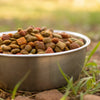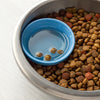How to Measure Dry Dog Food: A Comprehensive Guide for Pet Owners
- Houndsy
Table of Contents
- Introduction
- Why Accurate Measurement Matters
- The Common Pitfalls of Measuring Dog Food
- The Science of Accurate Measurement
- The Houndsy Kibble Dispenser: Elevating the Feeding Experience
- Best Practices for Measuring Dry Dog Food
- Conclusion
Introduction
Did you know that nearly 34% to 44% of dogs are estimated to be overweight? This staggering statistic highlights a growing concern among pet owners that often stems from the way we measure our furry friends' food. As responsible pet parents, we strive to provide the best for our dogs, but how accurate are we when it comes to measuring their meals? In this blog post, we will delve into the critical importance of measuring dry dog food accurately, explore the tools and techniques that can help us do so, and examine how our flagship product, the Houndsy Kibble Dispenser, can simplify this daily ritual.
By the end of this article, you will understand the nuances of measuring dry dog food, the potential pitfalls of inaccurate measurements, and how adopting a more reliable method can elevate the feeding experience for both you and your pet. We will also encourage you to reflect on your current feeding routine and consider how our innovative solutions can enhance it.
Why Accurate Measurement Matters
The Risks of Overfeeding and Underfeeding
The most pressing reason to measure your dog's food accurately is to prevent the negative health implications of overfeeding or underfeeding. Overfeeding can lead to obesity, which is associated with a myriad of health issues, including:
- Joint problems
- Diabetes
- Heart disease
- Reduced lifespan
Conversely, underfeeding can lead to malnutrition and a host of related health issues, including:
- Weight loss
- Weakened immune system
- Reduced energy levels
Understanding Caloric Needs
Every dog has unique caloric needs based on their age, weight, activity level, and health status. By accurately measuring their food, you ensure they receive the right amount of calories daily, which is essential for maintaining a healthy weight and overall wellness. A well-fed dog is a happy dog!
The Importance of Consistency
Consistency in feeding not only helps your dog maintain a healthy weight but also contributes to their overall behavior and mood. Dogs thrive on routine, and knowing they will receive the right amount of food at the same time each day helps set their internal clocks.
The Common Pitfalls of Measuring Dog Food
The Challenge of Measuring Cups
Many pet owners rely on standard measuring cups, often assuming that an "8-ounce cup" means the same thing across all brands and food types. However, this isn't the case. The weight of a cup of kibble can vary significantly based on:
- Kibble shape and size
- Ingredient density
- Moisture content
This variability can lead to discrepancies in portion sizes, resulting in under or overfeeding. Studies have shown that pet owners often mismeasure portions by 48% too little or 152% too much, especially when using liquid measuring cups that are intended for liquids, not solids.
Eyeballing It: A Dangerous Habit
Many pet owners admit to "eyeballing" the amount of food they are serving. This method is highly unreliable and can lead to significant inaccuracies over time. One generous scoop here and an extra handful there can add up quickly, contributing to obesity and other health issues.
The Science of Accurate Measurement
Using a Kitchen Scale
The most reliable method of measuring dry dog food is to use a kitchen scale. Weighing kibble ensures that you dispense the exact amount each time, making it easier to stick to your dog's caloric requirements. Here's how to do it:
- Choose the Right Scale: Look for a digital scale that measures in grams, as this is the most accurate way to portion your dog’s food.
- Tare the Scale: Place your dog’s bowl on the scale and zero it out so that you're only measuring the food.
- Add Food Until You Reach the Desired Weight: Pour the kibble until you reach the recommended weight as per your dog's dietary needs.
Consulting Feeding Guidelines
Most pet food manufacturers provide feeding guidelines on their bags, often indicating how much a specific volume corresponds to in grams. For example, a bag might state that 1 cup of kibble weighs 100 grams. Always check these guidelines and adjust according to your dog's specific needs.
The Houndsy Kibble Dispenser: Elevating the Feeding Experience
At Houndsy, we are dedicated to simplifying and enhancing the dog-feeding experience. Our flagship product, the Houndsy Kibble Dispenser, combines innovative design with functionality to help you measure and dispense your dog's food accurately.
Key Features
- Perfect Portion Control: Our dispenser allows for precise measurements with every crank, helping you avoid the inaccuracies associated with traditional measuring cups.
- Ergonomic Design: The standing-height crank eliminates the need for bending, making it easier on your back while maintaining a tidy feeding area.
- Large Storage Capacity: With a capacity of 25-30 lbs, the dispenser minimizes the frequency of refills.
- Freshness Guaranteed: The BPA-free liner ensures your dog’s kibble stays fresh and uncontaminated.
- Auto-Locking Mechanism: This feature prevents accidental dispensing, keeping curious pets and toddlers safe.
By incorporating the Houndsy Kibble Dispenser into your daily routine, you can ensure that your dog receives the right amount of food every time, enhancing their overall health and well-being.
Best Practices for Measuring Dry Dog Food
Choosing the Right Tools
- Use a Kitchen Scale: As mentioned, a kitchen scale is the best option for measuring dry dog food accurately. This will help you avoid the pitfalls of using cups that can lead to inconsistencies.
- Invest in Quality Measuring Cups: If you prefer using measuring cups, invest in a set of quality dry-food measuring cups specifically designed for pet food, as these are often more accurate than standard kitchen cups.
Preparing Your Dog’s Meals
- Measure Once a Day: Instead of measuring multiple times a day, consider measuring your dog's total daily food allowance at once. This can simplify your feeding routine and reduce the temptation to "eyeball" portions.
- Store Food Properly: Keep your dog’s food in a sealed container that is easy to access. This helps maintain freshness and makes it easier to measure out portions.
Adapting to Changes
Be aware that your dog's caloric needs may change due to factors like age, weight loss, or increased activity levels. Regularly reassess their food intake and adjust as necessary to ensure they are receiving the proper nutrition.
Conclusion
Accurate measurement of dry dog food is essential for maintaining your pet's health and well-being. By using a kitchen scale, consulting feeding guidelines, and leveraging innovative products like the Houndsy Kibble Dispenser, we can elevate the feeding experience for our furry companions.
As responsible pet owners, let’s commit to providing our dogs with the right amount of food every day. Not only will this help them maintain a healthy weight, but it will also contribute to a long and happy life. Reflect on your current feeding routine—are you measuring accurately? If not, consider making a change today!
FAQ
Q: How can I determine how much kibble my dog needs?
A: The best way to determine your dog's kibble needs is to consult the feeding guidelines provided by the pet food manufacturer and adjust based on your dog's specific health, age, and activity level.
Q: Is it better to use a scale or a measuring cup?
A: A kitchen scale is the most accurate tool for measuring pet food, as it allows you to weigh the exact amount of kibble. Measuring cups can lead to inconsistencies due to variations in kibble shape and density.
Q: Can I use the Houndsy Kibble Dispenser for other types of pet food?
A: While the Houndsy Kibble Dispenser is primarily designed for dry kibble, it is essential to ensure that the food type is suitable for the dispenser and does not cause any blockages.
Q: How often should I measure my dog's food?
A: It’s advisable to measure your dog's food daily to maintain consistency and ensure they are receiving the correct amount.
Q: What should I do if my pet is overweight?
A: Consult your veterinarian for a tailored feeding plan and consider monitoring their food intake closely using a scale or the Houndsy Kibble Dispenser to help manage portions effectively.












